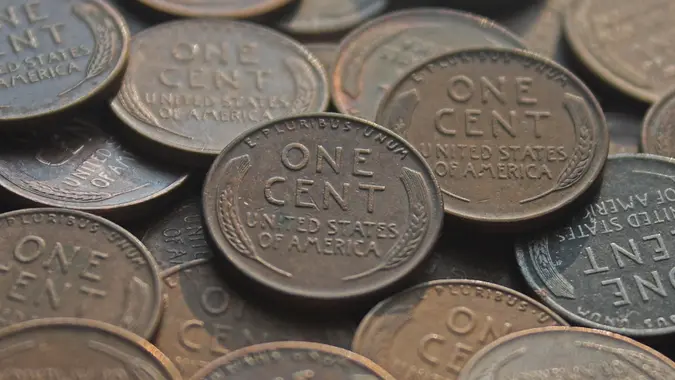Financial Influencer Vincent Chan Says There Are 7 Levels of Wealth — Where Do You Fall?

Commitment to Our Readers
GOBankingRates' editorial team is committed to bringing you unbiased reviews and information. We use data-driven methodologies to evaluate financial products and services - our reviews and ratings are not influenced by advertisers. You can read more about our editorial guidelines and our products and services review methodology.

20 Years
Helping You Live Richer

Reviewed
by Experts

Trusted by
Millions of Readers
If you’ve ever played a video game, you can relate to the concept of having to go through multiple levels to reach your goal. That could be defeating a dragon or rescuing royalty. Along the way you’ll, of course, encounter challenges. It’s not much different in your financial life than it is in video games (well, other than the fact that you can’t start over anew and you don’t get extra lives). In your financial life, you’re constantly unlocking levels of wealth — or, you should be, if you’re playing the game right.
But how many levels of wealth are there and what do they comprise? Financial influencer Vincent Chan broke it all down in a recent post on his YouTube channel. He not only identified the seven levels of wealth, but also explored how to transcend them.
Level 1: Clarity
The first level of wealth, according to Chan, is clarity. This ties in what Chan describes as “time wealth,” and that’s the concept that your wealth is determined not by how much you make but by how long it will last you.
“This is when you have enough time wealth to support you for 30 days or less,” Chan said. “At this stage, you’re constantly in survival mode, meaning that you’re probably living paycheck to paycheck.”
You definitely want to level up from this stage, regardless of whether you care to make it to the top level. You can do this by aggressively cutting your expenses. That could be as simple as doing what Chan does: meal plan and keep a list of what’s in your fridge so you know what you have and what you need to use.
Level 2: Self-Sufficiency
The second level of wealth is self-sufficiency. This is when you have enough wealth to support yourself for around two to three months. In this stage, you still don’t really have much wealth, and it’s likely you’re pretty anxious about money, particularly when you part with it.
Chan was at level two in college. To ascend, he did things like eat at home instead of dining out, have drinks at a friend’s place instead of going to a bar to get them and never brought his credit card with him on a night out. Cash only.
“Implementing these routines really helped make it easier for me to save money,” Chan said, adding that you too can break out of this level by building “a real financial cushion.” This means having a six-month emergency fund available, or an average of $33,000, in a high yield savings account, to cover unexpected costs.
Level 3: Breathing Room
This is the level where you finally start to feel some relief. It’s called breathing room. At this level of wealth, you have three to six months of “freedom time,” Chan said. “You can go out to eat without needing to triple-check your bank account. Or you can treat yourself to something without worrying about rent.”
Things are better than they used to be (if you went through level one and level two), but this stage can be a trap, Chan warned.
“It’s really tempting to stay in your comfort zone,” Chan said. “How can you move on to the next stage?”
He recommended increasing your income to get past this level. Doing so may hinge on going back to school to get an advanced degree, but it could also be a side hustle or an entrepreneurial project.
Level 4: Stability
Things are getting better! At level four, you have stability, which is a pretty good thing to have. You have an ample emergency fund, around six months to a year of time wealth and you’re not worrying about money. For many, this is a dream level of wealth, but you can go much further — especially if you want to buy a home.
If you want to get to stage five, you need to prioritize spending assets before liabilities. Here, Chan referred to Robert Kiyosaki’s famous book “Rich Dad Poor Dad,” in which Kioyosaki discussed how assets make you money and liabilities cost you money. You’ll want to think about making savvy investments. Think stocks and bonds, not luxury cars. Any income that comes in that isn’t expected, such as a gift, put half of it in a sound investment.
Level 5: Flexibility
Here’s where we really start to see some movement. At the fifth level of wealth, you can afford to support yourself for about one to two years without going completely broke.
“You start to get a taste of what financial freedom feels like,” Chan said. “You’re finally moving from financial security into financial opportunity.”
To ascend level five, you need to focus on tax reduction strategy and savvy investing. Embrace tax advantaged accounts such as 401(k) plans, Roths and HSAs. Invest what you save.
Level 6: Financial Independence
We see a major shift in wealth once we get to level six. This stage of financial independence means you have 30 to 60 years of time wealth, if you make all the right moves.
“At this stage, your money is literally working harder than you have to,” Chan said. “By now, your investments like stocks, your rental properties or other passive income streams can now effectively cover your living expenses completely.”
Level six is an awesome place to be. You can choose to work instead of having to work. You can donate to causes you care about without feeling like you’re making a sacrifice. But there is one final level above it, and it requires being more intentional about a word that may still drum up fear: debt.
To get to the next level, you need to use debt to your advantage.
“Most people understand debt as something to be really, really bad with, like, credit cards,” Chan said. “But for people at this level of wealth, they can use debt to their advantage. That may sound confusing. But consider how multimillionaires and billionaires operate. They, for example, take out massive loans to buy properties to then use their cash to invest in other assets that can make them more money.
“If we look at the breakdown of assets for actual economic wealth categories in the U.S., you can see that most of the upper-class wealth is held in business equity in stocks — meaning some of the wealthiest in the U.S. take out loans not just to buy real estate for themselves, but also on non-homeownership types of real estate like office complexes, residential apartments or motels.”
Level 7: Abundant Wealth
Here we are at the highest tier of wealth, where the richest people alive dwell. At this apex, you don’t just have time wealth for your life, you also have time wealth for future generations (hello, great wealth transfer!).
“At this stage, your options are nearly limitless,” Chan said. “And the beauty of having abundant wealth is that your money can extend far beyond just living a really comfortable life. If you are a good person, you can actually use some of your money to create something positive and lasting and good for the world.”
 Written by
Written by  Edited by
Edited by 

























